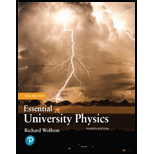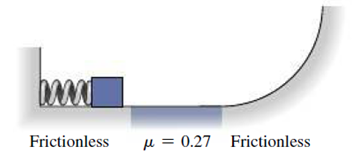1 Doing Physics 2 Motion In A Straight Line 3 Motion In Two And Three Dimensions 4 Force And Motion 5 Using Newton's Laws 6 Energy, Work, And Power 7 Conservation Of Energy 8 Gravity 9 Systems Of Particles 10 Rotational Motion 11 Rotational Vectors And Angular Momentum 12 Static Equilibrium 13 Oscillatory Motion 14 Wave Motion 15 Fluid Motion 16 Temperature And Heat 17 The Thermal Behavior Of Matter 18 Heat, Work, And The First Law Of Thermodynamics 19 The Second Law Of Thermodynamics expand_more
7.1 Conservative And Nonconservative Forces 7.2 Potential Energy 7.3 Conservation Of Mechanical Energy 7.4 Nonconservative Forces 7.5 Conservation Of Energy 7.6 Potential-energy Curves Chapter Questions expand_more
Problem 1FTD: Figure 7.14 shows force vectors at different points in space for two forces. Which is conservative... Problem 2FTD: Is the conservation-of-mechanical-energy principle related to Newtons laws, or is it an entirely... Problem 3FTD: Why cant we define a potential energy associated with friction? Problem 4FTD: Can potential energy be negative? Can kinetic energy? Can total mechanical energy? Explain. Problem 5FTD: If the potential energy is zero at a given point, must the force also he zero at that point? Give an... Problem 6FTD: If the difference in potential energy between two points is zero, does that necessarily mean that an... Problem 7FTD: If the difference in potential energy between two points is zero, does that necessarily mean that an... Problem 8FTD: If conservation of energy is a law of nature, why do we have programslike mileage requirements for... Problem 9E: Determine the work you would have to do to move a block of mass m from point 1 to point 2 at... Problem 10E: Now lake Fig. 7.15 lo lie in a vertical plane, and find the work done by the gravitational force as... Problem 11E: Rework Example 7.1, now taking the zero of potential energy at street level. EXAMPLE 7.1... Problem 12E: Find the potential energy associated with a 70-kg hiker (a) atop New Hampshires Mount Washington,... Problem 13E: You fly from Bostons Logan Airport, at sea level, to Denver, altitude 1.6 km. Taking your mass as 65... Problem 14E: How much energy can be stored in a spring with k = 320 N/m if the maximum allowed stretch is 18 cm? Problem 15E: How far would you have to stretch a spring with k = 1.4 kN/m for it to store 210 J of energy? Problem 16E: A biophysicist grabs the ends of a DNA strand with optical tweezers and stretches it 26 m. How much... Problem 17E: A skier starts down a frictionless 32 slope. After a vertical drop of 25 m, the slope temporarily... Problem 18E: A 10,000-kg Navy jet lands on an aircraft carrier and snags a cable to slow it down. The cable is... Problem 19E: A 120-g arrow is shot vertically from a bow whose effective spring constant is 430 N/m. If the bow... Problem 20E: In a railroad yard, a 35,000-kg boxcar moving at 7.5 m/s is stopped by a spring-loaded bumper... Problem 21E: You work for a toy company, and youre designing a spring-launched model rocket. The launching... Problem 22E: A 54-kg ice skater pushes off the wall of the rink, giving herself an initial speed of 3.2 m/s. She... Problem 23E Problem 24E: A particle slides along the frictionless track shown in Fig. 7.16, starting at rest from point A.... Problem 25E: A particle slides back and forth on a frictionless track whose height as a function of horizontal... Problem 26E: A particle is trapped in a potential well described by U(x) = 16x2 b, with U in joules, x in... Problem 27E: Example 7.3: A climbing rope is designed to exert a force given by F = −kx + bx3 where k = 244 N/m3,... Problem 28E: Example 7.3: A climbing rope exerts a force given by F = − kx − cx2 Find an expression for c such... Problem 29E: Example 7.3: The force on an electron in an experimental nanoscale electronic device is given by F =... Problem 30E: Example 7.3: The potential energy of an electron in an experimental nanoscale electronic device is... Problem 31E Problem 32E Problem 33E: Example 7.5: In a railroad switchyard, a rail car of mass 28,600 kg starts from rest and rolls down... Problem 34E Problem 35P: The reservoir at Northfield Mountain Pumped Storage Project is 214 m above the pump/generators and... Problem 36P: A carbon monoxide molecule can be modeled as a carbon atom and an oxygen atom connected by a spring.... Problem 37P: A more accurate expression for the force law of the rope in Example 7.3 is F = kx + bx2 cx3, where... Problem 38P: For small stretches, the Achilles tendon can be modeled as an ideal spring. Experiments using a... Problem 39P: A particle moves along the x-axis under the influence of a force F = ax2 + b, where a and b are... Problem 40P: As a highway engineer, youre asked to design a runaway truck lane on a mountain road. The lane will... Problem 41P: A spring of constant k, compressed a distance x, is used to launch a mass m up a frictionless slope... Problem 42P: A child is on a swing whose 3.2-m-long chains make a maximum angle of 50 with the vertical. Whats... Problem 43P: With x x0 = h and a = g, Equation 2.11 gives the speed of an object thrown downward with initial... Problem 44P: The nuchal ligament is a cord-like structure that runs along the back of the neck and supports much... Problem 45P: A 200-g block slides back and forth on a frictionless surface between two springs, as shown in Fig.... Problem 46P: Automotive standards call for bumpers that sustain essentially no damage in a 4-km/h collision with... Problem 47P: A block slides on the frictionless loop-the-loop track shown in Fig. 7.19. Find the minimum height h... Problem 48P: The maximum speed of the pendulum bob in a grandfather clock is 0.55 m/s. If the pendulum makes a... Problem 49P: A mass m is dropped from height h above the top of a spring of constant k mounted vertically on the... Problem 50P: A particle with total energy 3.5 J is trapped in a potential well described by U = 7.0 8.0x +... Problem 51P: (a) Derive an expression for the potential energy of an object subject to a force where a = –26.5... Problem 52P: In ionic solids such as NaCl (salt), the potential energy of a pair of ions takes the form U = b/rn ... Problem 53P: Repeat Exercise 19 for the case when the coefficient of kinetic friction on both slopes is 0.11,... Problem 54P: As an energy-efficiency consultant, youre asked to assess a pumped-storage facility. Its reservoir... Problem 55P: A spring of constant k = 340 N/m is used to launch a 1.5-kg block along a horizontal surface whose... Problem 56P: A bug slides back and forth in a bowl 15 cm deep, starting from rest at the top, as shown in Fig.... Problem 57P: A 190-g block is launched by compressing a spring of constant k = 200 N/m by 15 cm. The spring is... Problem 58P Problem 59P: An 840-kg roller-coaster car is launched from a giant spring with k = 31 kN/m into a frictionless... Problem 60P Problem 61P: A child sleds down a frictionless hill whose vertical drop is 7.2 m. At the bottom is a level but... Problem 62P: A bug lands on top of the frictionless, spherical head of a bald man. It begins to slide down his... Problem 63P: A particle of mass m is subject to a force F=(ax)l, where a is a constant. The particle is initially... Problem 64P: A block of weight 4.5 N is launched up a 30 inclined plane 2.0 m long by a spring with k = 2.0 kN/m... Problem 65P: Your engineering department is asked to evaluate the performance of a new 370-hp sports car. You... Problem 66P: Your roommate is writing a science fiction novel and asks your advice about a plot point. Her... Problem 67P: You have a summer job at your universitys zoology department, where youll be working with an animal... Problem 68P: Biomechanical engineers developing artificial limbs for prosthetic and robotic applications have... Problem 69P: Blocks with different masses are pushed against a spring one at a time, compressing it different... Problem 70PP: Nuclear fusion is the process that powers the Sun. Fusion occurs when two low-mass atomic nuclei... Problem 71PP: Nuclear fusion is the process that powers the Sun. Fusion occurs when two low-mass atomic nuclei... Problem 72PP: Nuclear fusion is the process that powers the Sun. Fusion occurs when two low-mass atomic nuclei... Problem 73PP: Nuclear fusion is the process that powers the Sun. Fusion occurs when two low-mass atomic nuclei... format_list_bulleted



 Principles of Physics: A Calculus-Based TextPhysicsISBN:9781133104261Author:Raymond A. Serway, John W. JewettPublisher:Cengage Learning
Principles of Physics: A Calculus-Based TextPhysicsISBN:9781133104261Author:Raymond A. Serway, John W. JewettPublisher:Cengage Learning Physics for Scientists and Engineers, Technology ...PhysicsISBN:9781305116399Author:Raymond A. Serway, John W. JewettPublisher:Cengage Learning
Physics for Scientists and Engineers, Technology ...PhysicsISBN:9781305116399Author:Raymond A. Serway, John W. JewettPublisher:Cengage Learning University Physics Volume 1PhysicsISBN:9781938168277Author:William Moebs, Samuel J. Ling, Jeff SannyPublisher:OpenStax - Rice University
University Physics Volume 1PhysicsISBN:9781938168277Author:William Moebs, Samuel J. Ling, Jeff SannyPublisher:OpenStax - Rice University Physics for Scientists and Engineers: Foundations...PhysicsISBN:9781133939146Author:Katz, Debora M.Publisher:Cengage Learning
Physics for Scientists and Engineers: Foundations...PhysicsISBN:9781133939146Author:Katz, Debora M.Publisher:Cengage Learning Physics for Scientists and Engineers with Modern ...PhysicsISBN:9781337553292Author:Raymond A. Serway, John W. JewettPublisher:Cengage Learning
Physics for Scientists and Engineers with Modern ...PhysicsISBN:9781337553292Author:Raymond A. Serway, John W. JewettPublisher:Cengage Learning College PhysicsPhysicsISBN:9781285737027Author:Raymond A. Serway, Chris VuillePublisher:Cengage Learning
College PhysicsPhysicsISBN:9781285737027Author:Raymond A. Serway, Chris VuillePublisher:Cengage Learning




